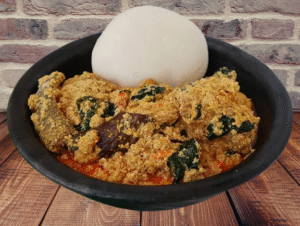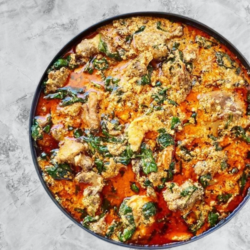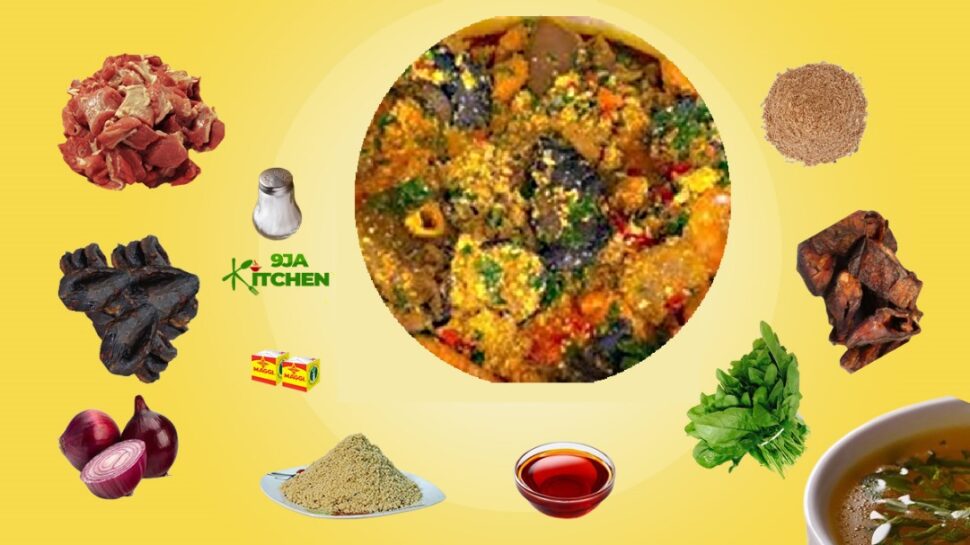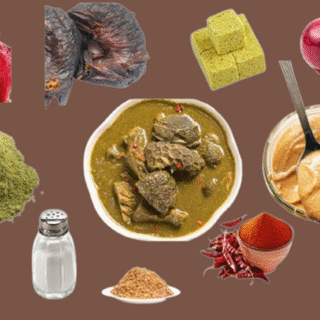Introducing the Boiled Method of Egusi Soup📢
How to make Egusi Soup using the boiled method is one of the most cherished cooking styles in Nigerian cuisine. Egusi soup, prepared with melon seeds, vegetables, palm oil, and proteins, is a staple dish across West Africa, particularly in Nigeria. The boiled method of Egusi Soup ensures that the melon seeds (egusi) are simmered slowly, allowing the flavours to blend beautifully, resulting in a thick, hearty, and comforting soup.
In this post, you’ll learn how to make Egusi Soup using the boiled method, discover essential tips, explore nutritional benefits, and get answers to frequently asked questions.
Food may be the fuel our bodies use to function, but good food is the fuel our souls use to thrive
Table of Contents
Why Choose the Boiled Method?🥘
How to make Egusi Soup using the boiled method gives the soup a unique texture and deeper flavour compared to the frying method. Instead of frying the ground melon seeds, they are boiled gently with meat stock and other ingredients, making the soup lighter, healthier, and richer in nutrients.
This style is loved by those who prefer less oily meals while still enjoying the authentic taste of Egusi Soup.
Ingredients Needed🥩
Here’s what you’ll need for how to make Egusi Soup using the boiled method:
- 2 cups ground egusi (melon seeds)
- 500g assorted meat (goat meat, beef, or chicken)
- 200g stockfish (optional)
- 1 cup dry fish (washed and deboned)
- 2 cooking spoons of palm oil
- 2–3 tablespoons ground crayfish
- 2 seasoning cubes
- 1 medium onion (chopped)
- 2 scotch bonnet peppers (blended)
- 2 cups chopped spinach, ugu (fluted pumpkin leaves), or kale
- 3–4 cups meat stock or water
- Salt to taste
Equipment Needed🍳
- 1 Large cooking pot
- 1 blending machine or grinding stone
- Mortar and Pestle: For grinding pepper
- Wooden spoon or ladle
- Kitchen knife and chopping board
- bowl for washing
- Strainer (for dry fish and stockfish)
Step-by-Step Guide on How to Make Egusi Soup Using the Boiled Method👩🏽🍳
Step 1: Prepare the Meat and Stock
- Season your assorted meat with onions, seasoning cubes, and salt.
- Add water and boil until tender (10–15 minutes).
- Keep the flavorful stock aside.
- It will serve as the base for your soup.
Step 2: Mix the Egusi
- In a bowl, mix ground egusi with a little water to form a thick paste. This prevents lumps when cooking.
This step is crucial in how to make Egusi Soup using the boiled method.
Step 3: Add Egusi to Stock
- Once the meat is tender, add palm oil to the pot and allow it to cook for about 5 minutes. This gives the oil time to mix with the meat flavours.
- Gently fold in the egusi paste, making sure it spreads across the pot and cooks evenly.
- Allow it to cook for about 15-20 minutes, stirring occasionally to prevent burning.
- Let it simmer until the egusi thickens and releases its nutty aroma.
This is where how to make Egusi Soup using the boiled method differs most from frying.
Step 4: Introduce Palm Oil and Seasoning
- Stir in crayfish, blended pepper, and seasoning cubes.
- Allow to cook for 10–15 minutes while stirring occasionally.
Step 5: Add Fish and Meat
- Introduce the dry fish, stockfish, and pre-cooked meat.
- Allow them to absorb the rich flavours of the soup.
Step 6: Add Vegetables
- Finally, add chopped vegetables, stir gently, and cook for another 3–5 minutes.
- Adjust salt to taste.


Egusi Soup Served with Pounded Yam
Tips for Perfect Egusi Soup (Boiled Method)🌿
- Always soak stockfish and dry fish in warm water before cooking.
- Don’t add too much palm oil—just enough for flavour and colour.
- If you prefer a thicker soup, add more ground egusi.
- Avoid overcooking the vegetables to preserve their nutrients and colour.
Following these tips ensures success in how to make Egusi Soup using the boiled method every single time.
Boiled Method Egusi Soup Recipe

Egusi Soup – Boiled Method
Equipment
- 1 Large cooking pot
- 1 Blending Machine
- Bowels
- Cooking spoons
Ingredients
- 4 Cups (500g) Egusi (Melon) seeds
- 4 Cups Water
- 3 3 cooking spoons red palm oil
- 2 kg Meat (Assorted) don't forget to add good quantity of cow tripe (Shaki).
- 1-2 Dry Fish
- Stockfish
- Iru (Ogiri Okpei) optional
- Pepper to taste
- Salt to taste
- 3-4 stock cubes
- Spinach or Bitter leaf or Pumpkin leaf
Instructions
PREPARATION BEFORE COOKING THE SOUP
- Soak the dried fish in water until it becomes soft. Then, boil the fish in a pot with water until it is fully cooked. This will create a fish stock that can be used in soups, stews, or other dishes that require a flavourful broth.If you are using tough stockfish, you should boil it for 20 minutes and then let it soak in the pot with the hot water for about an hour. However, if you are using softer stockfish, it is enough to soak them in cool water until you can break them apart with your hands.
- Once the fish and stockfish have become soft, remove the bones and break them into chunks of a suitable size.
- Make sure to rinse the vegetables that you plan to use and then cut them into small pieces.
- Much closer to cooking time, grind egusi, crayfish, and dry pepper separately.
BOILED EGUSI SOUP PREPARATION
- To cook the beef and fish with the stock cubes, you should start by cooking the toughest meat and fish first and add the rest as they get done. If using a regular pot, begin with stockfish and shaki, add beef after about an hour and cook until it is well done. You can add the dry fish when all the other meat and fish are cooked because it is already cooked. You just need to cook it long enough until it is soft and integrated with the rest of the ingredients. Using a pressure pot is a different process, but that is something for another post.
- Once the protein has been cooked to a point where it is soft and tender, it is time to infuse the dish with the necessary amount of water to create a rich and flavorful soup. Be sure to add enough water to produce the desired quantity of soup, allowing the protein to blend perfectly with the liquid for a delicious and satisfying meal.
- Enhance the taste and texture of your dish by adding the exquisite flavor of palm oil. Please add palm oil.
- Enhance the flavor and aroma of the dish by adding some expertly blended peppers and seasoning.
- To add a burst of flavor to your dish, I suggest adding a generous amount of blended crayfish. Gently stir the crayfish into your dish and cover the pot to allow it to come to a boil. This will help to infuse the dish with the rich and savory taste of the crayfish.
- Add the blended egusi and stir well until it comes to a boil. Get ready to indulge in an explosion of flavors that will leave your taste buds craving for more.
- Add Vegetables. When preparing your dish, you have the freedom to select the type of vegetable that best suits your taste preference. Some popular options include bitterleaf, pumpkin leaf, spinach, or Uziza. It is crucial to ensure that you thoroughly wash the vegetable of your choice before proceeding with the recipe. Taking this step will help to get rid of any dirt, debris or impurities, leaving you with fresh and clean produce for your dish.
- Stir the vegetables and cover the pot to cook for 2 minutes. If using bitterleaf, cook for 7 minutes.
- Empty the soup into a cool bowl to retain the freshness of the vegetables.
Notes
Nutritional Information (Approximate per Serving)🍽️
Nutritional Information (Approximate per Serving
- Calories: 460 kcal
- Protein: 35g
- Fat: 28g
- Carbohydrates: 15g
- Fiber: 3g
- Sodium: 780mg
Health Benefits of Egusi Soup🧑🏽⚕️
- Promotes Weight Management:
The high protein and fiber content can help keep you full longer, reducing overall caloric intake.
- Boosts Immune System:
The vitamins and minerals, particularly zinc and vitamin A, help strengthen the immune system↗.
- Heart Health:
The healthy fats present can support cardiovascular health by managing cholesterol levels.
- Supports Bone Health:
The calcium and magnesium in egusi and leafy vegetables contribute to strong bones.
- Improved Digestion:
The fiber content aids in digestive health and can prevent constipation.
- Provides Energy:
The combination of protein, healthy fats, and carbohydrates from other ingredients provides a sustained energy source.
Health Risks🧑🏽⚕️
- Caloric Density:
Egusi is calorie-dense due to its high fat content. Overconsumption could lead to weight gain if not balanced with other foods. - Allergens:
Some individuals may be allergic to nuts and seeds, including melon seeds, which could lead to severe allergic reactions.
- High Sodium Content:
Depending on how much salt is used, egusi soup can be high in sodium, which may raise blood pressure in sensitive individuals.
- Raw Consuming Risks:
Raw egusi seeds contain some toxic compounds. It is critical to cook them thoroughly to eliminate these toxins. - Underlying Health Conditions:
Individuals with underlying health conditions should consult healthcare professionals regarding the consumption of high-fat foods like palm oil.
FAQs on How to Make Egusi Soup Using the Boiled Method🙋🏽
Q1: Can I make Egusi Soup without palm oil?
👉Yes, but palm oil adds authentic flavour and colour. You can substitute with vegetable oil if necessary.
Q2: What is the difference between the boiled method and the frying method?
👉The boiled method simmers egusi in stock, making it lighter and less oily, while the frying method sautés egusi in palm oil before cooking.
Q3: Can I store Egusi Soup?
👉Yes, Egusi Soup stores well in the freezer for up to 1 month. Reheat gently before serving.
Q4: What can I eat Egusi Soup with?
👉Serve with pounded yam, fufu, eba (garri), rice, or semovita.
Conclusion:
Egusi soup is a delightful and nourishing dish that brings many health benefits. As you savour its flavours, remember to consume it mindfully, given its calorie density and potential allergens. By using the boiled method, you can create a fulfilling meal that truly satisfies and nourishes you. Enjoy your cooking journey!
If you enjoyed reading this article, you might also like to check out the following Nigeria recipes.
How to make egusi soup (boiled method)
How to make egusi soup (Moulded method)
How to make egusi soup (fried method)
How to make bitterleaf soup
How to make okra soup (ofe okwuru)
How to make fisherman’s soup
How to make ofe Owerri soup
How to make oha soup (ofe oha)
How to make ogbono soup (ofe ogbono)
How to make seafood okra
- How To Make Grape Hydration Smoothie – A Powerful And Refreshing Recipe🍇💧
- How To Make Apple Cinnamon Smoothie (The Ultimate Delicious & Powerful Recipe) 🍎✨
- How To Make A Pineapple Coconut Smoothie🍍 (Delicious & Powerful Energy Boost)
- How To Make Peach Sunrise Smoothie: The Ultimate Delicious & Energising Morning Drink 🍑✨
- How To Make A Chocolate Banana Energy Smoothie 🍫| A Delicious & Powerful Healthy Drink

Did you make this recipe? Please do leave a comment and rating on the blog. Tag us your picture on Instagram @real9jakitchen











